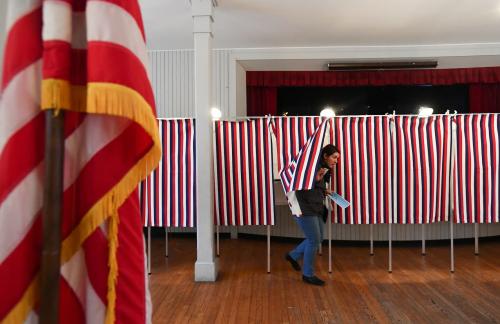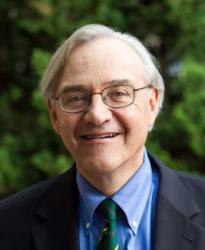In this series, we look at how younger voters are likely to impact future elections and American politics going forward.
“Awaken the body of Christ that we might pull back from this abyss.”
This was Sen. Ted Cruz’s prayerful closing plea to a crowd of about 150 people in Keosauqua, Iowa in late January 2016, less than a week before the state’s presidential caucuses. He made clear that he understood the stakes in his battle against Donald Trump.
The final days in the battle for Iowa — but also all the days to come in the fight for the Republican presidential nomination — would be marked by a struggle (political Armageddon, perhaps?), for the political souls of white evangelical Christians.
The first skirmish turned out not to be prophetic. Cruz prevailed over Trump in Iowa because the state’s powerful evangelical machinery and its loyal troops continued to be motivated, as Cruz hoped, by the issues of traditional religious conservatism, among them abortion and same sex marriage, and by solidarity with a candidate who could comfortably invoke scripture and evangelical language.
But over the long run, it was Trump who seized control of the white evangelical constituency on the basis of a shared anger and shared resentments rather than a shared faith. White evangelicals have remained one of Trump’s most loyal constituencies. He repaid their faithfulness with a Supreme Court majority that overturned Roe v. Wade and issued other rulings altering or abandoning post-1960 precedents on church-state issues. Holding his support among white evangelicals remains central to Trump’s strategy. “No president has ever fought for Christians as hard as I have,” Trump told the Faith & Freedom Coalition gala crowd in Washington in late June.
In 2024, Trump’s rivals for the Republican nomination — none more so than former Vice President Mike Pence, whom Trump put on his ticket to appeal to evangelicals — hope for a repeat of Iowa exceptionalism that would strike an early blow to Trump’s comeback effort. The particularities of Iowa make that possible.
But the evangelical political landscape is quite different than it was when Cruz made his appeal in Keosauqua and around the state. White evangelical politics is now predominantly the politics of older, conservative voters for whom “owning the libs” and pushing back hard against cultural and demographic change has become a sacred obligation.
The Trump appeal did not come from nowhere. The journey of white evangelical Christians towards the Republican Party, particularly in the South, began long before Roe v. Wade and the rise of the Moral Majority in the 1980’s and the Christian Coalition in the 1990’s. A backlash against the Democratic Party’s embrace of civil rights and voting rights sent white southern conservatives toward the GOP beginning in the 1948 election, and that group was also heavily evangelical. The shift reached a realigning point in 1964 when Barry Goldwater carried the Deep South against Lyndon B. Johnson, the champion of civil rights measures. It continued relentlessly, culminating in the Republican House takeover in 1994.
Even in 1980, when the religious conservative vote for Ronald Reagan was typically explained more by issues such as school prayer and abortion, race was an undercurrent as white southerners turned federal moves against “segregation academies,” set up by whites to escape racial integration, into attacks on “Christian academies.” Thus was the “religious liberty” slogan linked to racial discrimination. Racial backlash was by no means the only factor in the rise of religious conservatism. But the role of racial reaction and also immigration in pushing many white voters towards Trump was well-documented by political scientists Lynn Vavreck, Michael Tesier and John Sides in their book on the 2016 election, Identity Crisis.
The orientation of white evangelical politics towards Trump can be explained in part by the demographic base of white evangelicalism. White evangelicals are, by definition, white, significantly older than Americans as a whole, and also more southern. All these groups are more inclined to Republicans generally and to Trump in particular.
According to data analyzed by PRRI in 2023, 59% of white evangelicals are 50 years old or older, compared with 48% of all Americans. Among all Americans in the survey, 38% were from the South (and 36% of all white southerners); among white evangelicals, 52% hailed from the South.
But demography doesn’t explain everything. Yes, white evangelicals are older than Americans as a whole. But white mainline Protestants and white Catholics are even older than white evangelicals. Sixty-two percent of white mainline Protestants and fully 66% of white Catholics are age 50 and older.
Differences in educational attainment are large. Forty-two percent of white evangelicals have a high school degree or less, compared to 31% for white mainline Protestants and Catholics. Conversely, just 26% of white evangelicals have a BA or more, compared to 40% for white mainliners and 44% for white Catholics.
White evangelicals are also distinctive in partisanship and ideology, PRRI’s analysis of data from its 2022 American Values Survey found: 61% percent identify as Republicans, and 69% as conservatives. The comparable figures for white mainline Protestants are 39% and 42%; for white Catholics, 41% and 42%. Not surprisingly, 63% of white evangelicals have favorable attitudes towards Donald Trump, compared to just 40% of white mainline Protestants and 41% of white Catholics.
However, white Christians have been shrinking as a proportion of the population. As recently as 2006, white evangelicals, mainliners, and Catholics made up 57% of the total. Today, they account for just 42%. On the other hand, this decline occurred before 2019 and has stabilized since then. The white evangelical share shrank rapidly from 23% to 15% between 2006 and 2018, and then at a slower pace, to its current level of 14%.
This decline is the result of two factors: the surge in the share of Americans who are religiously unaffiliated, and the growing racial diversity of the country. The Census found that the overall white share of the population fell from 69% in 2000 to 60% in 2020. Among the youngest cohort, the drop was steeper — from 61% to 50%.
It’s important to stress that the interaction of religious faith and politics works in both directions. If religious orientation influences political views, perceptions of the political inclinations of religious traditions influences attitudes towards faith. As Robert Putnam and David Campbell argued in their magisterial book American Grace, the association of Christian traditions with conservative or right-wing politics — particularly on LGBTQ issues — has played an important role pushing progressive young people away from religion altogether. The result is a religious generation gap. Among Americans aged 18 to 29, 38% are religiously unaffiliated, as are 32% of those aged 30 to 49, according to PRRI data. But only 20% of those aged 50 to 64 and 17% of those over 65 are in the ranks of the religiously unaffiliated.
These broad changes provide perspective on the stark differences among generations in their religious composition. Among Americans 65 and older, 18% are white evangelicals, compared with just 9% of Americans ages 18 to 29. But white mainliners show a similar pattern of decline, representing 20% of Americans over 65, but 10% of Americans 18 to 29. The generational decline among white Catholics is even more dramatic, from 20% of the oldest cohort to just 7% of the youngest. It’s thus important to be clear: Evangelicals have not declined as a share of white Christians. But white Christians have declined as a share of the overall population.
A Pew Research Center study of white Americans during the Trump presidency confirms this picture of relative stability in recent years. Between 2016 and 2020, the share of whites identifying as evangelical Protestants rose from 25 to 29%, the study found, while white mainliners fell from 20 to 17% and white Catholics remained at 18%. Remarkably, white evangelicals who opposed Trump were no more likely than their Trump-supporting brethren to leave the fold. Indeed, more white evangelicals converted to Trump’s cause than defected from it during his presidential years, which is why his share of their vote increased to 84% in 2020 from its already high level of 77% in 2016.
Because so much has been made of Trump’s strength among white evangelicals, it needs to be underscored that this was not in any way an innovation in American voting patterns. Trump was simply building on a long era of Republican dominance. The exit polls found that white evangelicals cast 79% of their ballots for Mitt Romney in 2012 and George W. Bush in 2004. John McCain secured 74% in 2008.
Younger cohorts in the broader population have become more progressive on many social questions, and younger white evangelicals are not immune to these shifts. For example, only 27% of white evangelicals 65 and older support same-sex marriage, compared to 43% of those ages 18 to 29 and 47% of those between 30 and 49. Other surveys suggest the relative moderation of younger white evangelicals on environmental issues and the role of government.
But on abortion, there are no significant differences across white evangelical age cohorts. If anything, the youngest cohort is the most conservative of all on this pivotal issue. PRRI found that 38% of white evangelicals ages 18 to 29 say that abortion should be illegal in all cases, compared to 27% of 30-to-49-year-olds, 17% of those between 50 and 64, and 15% of those 65 and older. This supports the view of Robert Jones, who heads the Public Religion Research Institute, that the more moderate young white evangelicals have been the most likely to look elsewhere for spiritual and cultural guidance. As a result, younger Americans who have remained evangelical are among the most conservative members of their generation.
Despite their declining share of the electorate since the beginning of the 21st century, white evangelicals continue to represent a formidable voting bloc. They constitute about 30% of Republican identifiers as well as 14% of the electorate. They are roughly the same share of the total as African Americans, and their overwhelming support for Republican candidates just about counterbalances African Americans’ comparable loyalty to the Democrats.
The power of the white evangelical vote in Republican primaries — and particularly in the caucuses in Iowa — will make them a driving force in 2024 politics. This complicates the GOP’s response to the Dobbs decision. Republicans in swing districts and swing states who would prefer to play down abortion face strong resistance from evangelical quarters and the party’s presidential candidates need to win primaries before they get to the November ballot.
In one sense, at least, 2024 will be like 2016: Many Republican candidates — notably Mike Pence, Tim Scott and Ron DeSantis — are more biblically literate and more fluent in evangelical language than Trump. This was Ted Cruz’s bet, and it worked in Iowa. But by casting the country’s political struggle as a form of cultural and spiritual Armageddon, Trump has made himself the dominant figure on the religious right. These voters love him for the enemies he has made and for his willingness to fight them ferociously. They seem in no mood to abandon him now that he stands in legal jeopardy.
The Brookings Institution is committed to quality, independence, and impact.
We are supported by a diverse array of funders. In line with our values and policies, each Brookings publication represents the sole views of its author(s).









Commentary
How younger voters will impact elections: What is happening to the white evangelical vote?
June 27, 2023